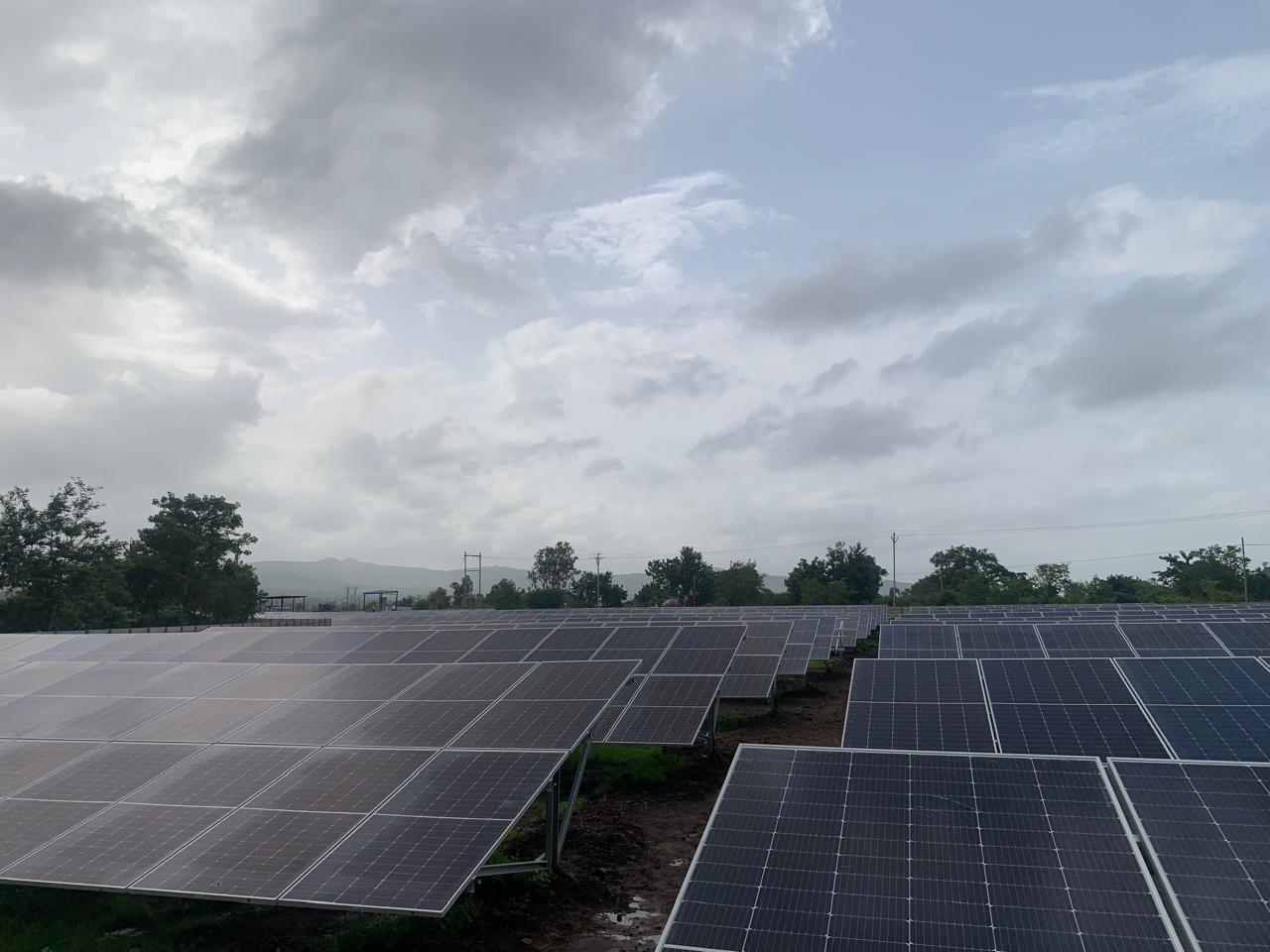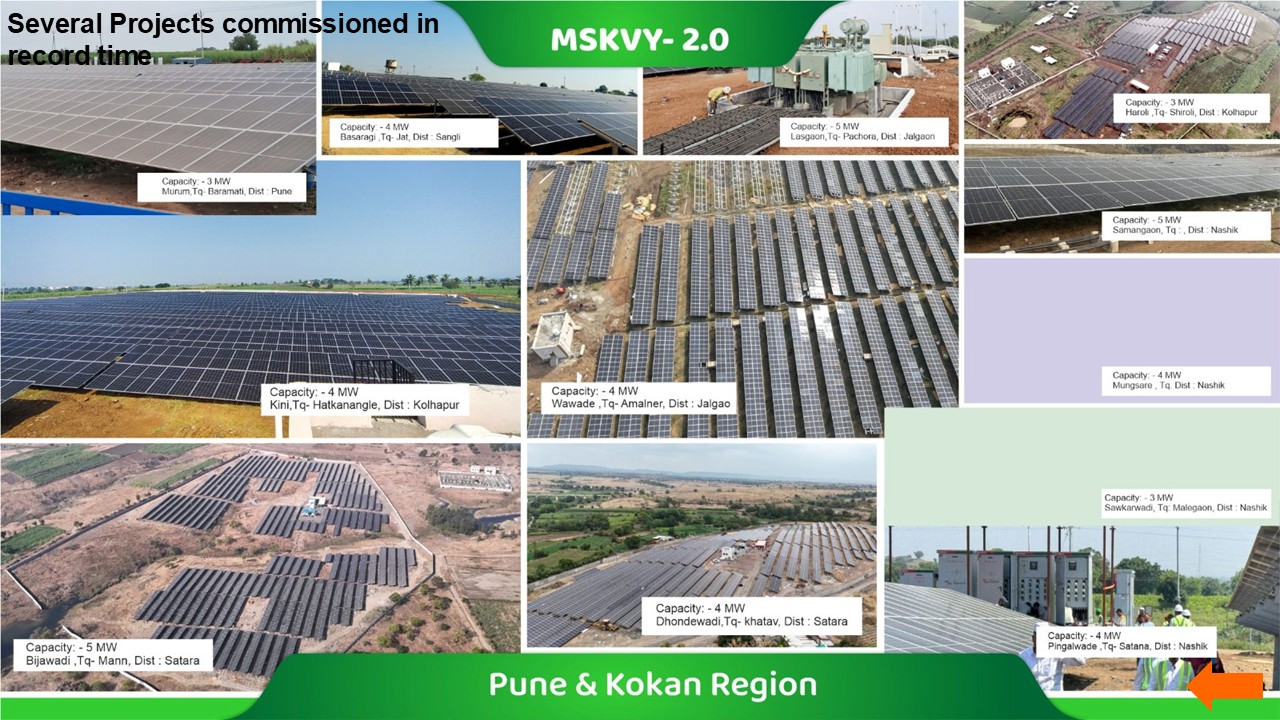MUKHYAMANTRI SAUR KRUSHI VAHINI YOJANA – 2.0 – MSEB Solar Agro Power Limited

MUKHYAMANTRI SAUR KRUSHI VAHINI YOJANA
Problem
- Approximately 4 acres are required per MW of solar capacity, which is difficult to secure across Maharashtra.
- Timely approvals and signing of PPAs with developers posed major bottlenecks.
- Establishing 16,000 MW required an investment of nearly ₹80,000 crore, a major capital challenge.
- MSEDCL faced rising debts and inefficiencies, weakening operational capabilities.
- Existing systems required strengthening to absorb decentralised solar power seamlessly.
Solution
- Unique design tailored to Maharashtra’s needs for agricultural solarisation.
- Implementation of single-window online portals for land bank management, statutory approvals, and real-time project monitoring.
- Involvement of multiple departments — Revenue, Forest, Rural Development — for smooth project facilitation.
- Use of the e-Bharat Portal for e-auctions ensures competitive, fair tariff discovery.
- Coordination between transmission and distribution utilities for effective grid integration and system upgrades.
Outcomes
- Maharashtra achieved 60% RE capacity mix target; 16 GW of distributed solar implemented under MSKVY 2.0.
- 6 lakh+ agriculture consumers now receive reliable daytime power; farmers also benefit from land leasing income.
- Secured ₹80,000 crore investment (60% from private sector), generating large-scale employment and local growth.
- 30% emissions reduction by 2030 and major progress toward national renewable targets.
- Upgraded grid infrastructure and financial reforms have enhanced MSEDCL’s efficiency and sustainability.
Challenges
- Initial delays due to scattered and disputed ownership.
- Inadequate early investment in grid expansion risked power evacuation issues.
- Integrating large intermittent RE capacity required robust balancing mechanisms.
- Approvals across multiple authorities slowed early execution.
- Limited public awareness initially caused delays and pushback in rural zones.
Innovations
- GIS-enabled portal mapping substation catchments and land availability within 5–10 km for faster solar park siting.
- End-to-end digital monitoring platform for all approvals, documentation, and performance over 25 years.
- Enabled small and large investors to participate, maximizing capacity allocation efficiency.
- Integration with PM-KUSUM-C for central financial assistance and risk mitigation.
- Fully paperless, transparent process using online document registry, automated approvals, and grievance redressal modules.
SKOCH Award Nominee
Category: Government Undertaking
Sub-Category: Government Undertaking
Project: MUKHYAMANTRI SAUR KRUSHI VAHINI YOJANA – 2.0
Start Date: 5-08-2023
Organisation: MSEB Solar Agro Power Limited
Respondent: Abha Shukla
https://pmuportal.mahadiscom.in/
Level: Premium
Video
See Presentation
Gallery
Case Study
Mukhyamantri Saur Krushi Vahini Yojana (MSKVY) 2.0
Maharashtra, home to more than ten million farmers, faces one of India’s highest agricultural electricity demands. Nearly 30% of the state’s power consumption comes from the agriculture sector, much of it supplied at night through heavily subsidised electricity. This dependency not only imposed a growing financial burden on the state but also affected farmers’ productivity and safety. Recognising these challenges, the Government of Maharashtra launched the Mukhyamantri Saur Krushi Vahini Yojana (MSKVY) 2.0 on 8 May 2023, under the PM-KUSUM-C initiative, with the vision of providing reliable daytime power to farmers through decentralised solar generation.
The scheme’s design addressed multiple systemic problems that hindered large-scale renewable adoption. Land availability was a critical barrier—approximately four acres are required for every megawatt of solar capacity. To overcome this, MSEB Solar Agro Power Limited (MSAPL) developed a GIS-based Land Bank Portal to identify and lease government land within a 5–10 km radius of substations. Further, a single-window online approval system was introduced to expedite clearances, while the e-Bharat Portal ensured transparency and competitiveness in the tendering process. A dedicated Project Monitoring Unit (PMU) portal was also established to manage all project documentation and real-time tracking of implementation progress across 2,659 substations.
Through this digitally enabled, cluster-based approach, 15,404 MW of solar capacity was awarded in record time, with 2,014 MW already commissioned. The program successfully delivered eight hours of reliable daytime electricity to over six lakh agricultural consumers. Beyond addressing power reliability, MSKVY 2.0 contributed significantly to rural economic growth—generating employment, attracting ₹80,000 crore in investments (60% from the private sector), and reducing subsidy burdens on the government. Additionally, it aligned Maharashtra with national renewable energy and carbon reduction goals, achieving notable progress toward 60% renewable capacity by 2030.
Implementation, however, was not without challenges. Land acquisition complexities, grid stability issues, and multi-departmental coordination initially slowed progress. Yet, through proactive governance, transparent processes, and stakeholder engagement, these barriers were systematically mitigated. The scheme’s integrated design—combining technology, policy reform, and institutional collaboration—made it a replicable model for other states like Madhya Pradesh and Karnataka.
For more information, please contact:
Abha Shukla at msebsap@gmail.com
(The content on the page is provided by the Exhibitor)




